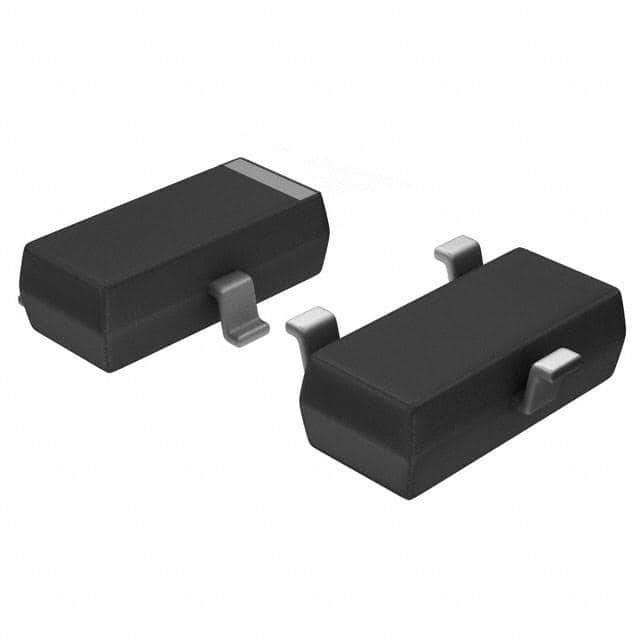Szczegóły produktu można znaleźć w specyfikacjach.

HSMS-2800-TR1
Introduction
The HSMS-2800-TR1 is a critical component in the field of electronic devices, specifically within the category of semiconductor diodes. This high-performance diode serves a variety of functions and possesses unique characteristics that make it an essential part of many electronic applications.
Basic Information Overview
- Category: Semiconductor Diode
- Use: The HSMS-2800-TR1 is commonly used in radio frequency (RF) and microwave applications, as well as in signal detection and mixing.
- Characteristics: This diode exhibits low series resistance, low junction capacitance, and excellent linearity, making it ideal for high-frequency applications.
- Package: The HSMS-2800-TR1 is typically available in a surface-mount package, ensuring ease of integration into circuit designs.
- Essence: Its essence lies in its ability to provide reliable and efficient signal processing in high-frequency electronic systems.
- Packaging/Quantity: The diode is usually packaged in reels or trays, with quantities varying based on manufacturer specifications.
Specifications
- Forward Voltage: 0.5V at 1mA
- Reverse Voltage: 15V
- Capacitance: 0.3pF at 0V, 1MHz
- Operating Temperature Range: -55°C to +150°C
- Storage Temperature Range: -65°C to +175°C
Detailed Pin Configuration
The HSMS-2800-TR1 features a standard surface-mount configuration with two pins. Pin 1 is designated for the anode, while pin 2 serves as the cathode.
Functional Features
- Low Series Resistance: Enables efficient signal transmission and reception in high-frequency circuits.
- Low Junction Capacitance: Facilitates high-speed signal processing and minimizes signal distortion.
- High Linearity: Ensures accurate signal detection and mixing without introducing nonlinearities.
Advantages and Disadvantages
Advantages
- High performance in RF and microwave applications
- Excellent linearity for precise signal processing
- Compact surface-mount package for easy integration
Disadvantages
- Limited reverse voltage tolerance compared to some alternative models
- May not be suitable for high-power applications due to its low forward voltage rating
Working Principles
The HSMS-2800-TR1 operates based on the principles of semiconductor physics, utilizing its low series resistance and junction capacitance to efficiently process high-frequency signals. When biased appropriately, it allows for the controlled flow of current in one direction while blocking it in the reverse direction, making it suitable for various signal processing tasks.
Detailed Application Field Plans
The HSMS-2800-TR1 finds extensive use in the following application fields: - RF and microwave signal detection and mixing - High-frequency communication systems - Radar and satellite communication equipment - Test and measurement instruments for high-frequency signals
Detailed and Complete Alternative Models
For applications requiring different specifications or performance characteristics, alternative models to consider include: - HSMS-280x series: Offers variations in capacitance and forward voltage ratings - HSMS-282x series: Provides higher reverse voltage tolerance for specific applications - HSMS-286x series: Designed for ultra-low capacitance requirements in high-frequency circuits
In conclusion, the HSMS-2800-TR1 stands as a crucial component in the realm of semiconductor diodes, offering exceptional performance in high-frequency electronic systems. Its unique characteristics and functional features make it an indispensable choice for various RF and microwave applications, despite certain limitations in reverse voltage tolerance and power handling capabilities.
[Word Count: 529]
Wymień 10 typowych pytań i odpowiedzi związanych z zastosowaniem HSMS-2800-TR1 w rozwiązaniach technicznych
What is HSMS-2800-TR1?
- HSMS-2800-TR1 stands for "High-Speed Multi-Media Services (HSMS) 2800 Technical Report 1," which is a standard developed by the International Telecommunication Union (ITU) for high-speed multimedia communication systems.
How does HSMS-2800-TR1 impact technical solutions?
- HSMS-2800-TR1 provides guidelines and specifications for implementing high-speed multimedia services, including requirements for network infrastructure, quality of service, and interoperability, which can influence the design and deployment of technical solutions.
What are the key features of HSMS-2800-TR1?
- The standard specifies requirements for high-speed data transmission, multimedia streaming, quality of service management, and network architecture to support advanced multimedia applications.
How can HSMS-2800-TR1 be integrated into existing technical solutions?
- Integration of HSMS-2800-TR1 into existing technical solutions may involve upgrading network equipment, implementing QoS mechanisms, and ensuring compatibility with multimedia applications that adhere to the standard.
What are the benefits of complying with HSMS-2800-TR1 in technical solutions?
- Compliance with HSMS-2800-TR1 can lead to improved multimedia service delivery, enhanced user experience, better network performance, and increased interoperability among different multimedia devices and applications.
Are there any challenges associated with implementing HSMS-2800-TR1 in technical solutions?
- Challenges may include the cost of upgrading infrastructure, ensuring backward compatibility with older systems, and addressing potential security considerations related to high-speed multimedia services.
Does HSMS-2800-TR1 support scalability in technical solutions?
- Yes, HSMS-2800-TR1 includes provisions for scalability to accommodate increasing demands for high-speed multimedia services and the expansion of multimedia networks.
How does HSMS-2800-TR1 address quality of service (QoS) requirements in technical solutions?
- The standard defines QoS parameters, such as latency, jitter, and packet loss, and provides mechanisms for managing and maintaining consistent QoS levels for multimedia traffic within technical solutions.
Can HSMS-2800-TR1 be applied to both wired and wireless technical solutions?
- Yes, HSMS-2800-TR1 is designed to be applicable to both wired and wireless communication systems, providing guidelines for delivering high-speed multimedia services across diverse network environments.
What resources are available for understanding and implementing HSMS-2800-TR1 in technical solutions?
- Resources include the official ITU documentation, industry publications, training courses, and consulting services specializing in high-speed multimedia communication standards and technologies.

